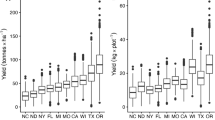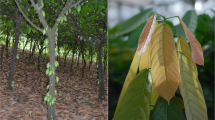Abstract
Productivity of forest tree plantations can be maximised by matching genetically improved planting stock to environments where it performs best. Radiata pine (Pinus radiata D. Don) breeding and deployment of genetically improved stock in Australia are currently based on the National Plantation Inventory (NPI) regions. These regions are not based on environmental drivers and biological patterns of genotype by environment interaction (G × E), so they may not deliver optimal genetic gains across plantation areas in Australia. This study used diameter at breast height data from trial sites with common parents to estimate site–site and age–age additive genetic correlations, and compile them into a database. A custom-built script in R was developed, which models the correlation estimates by minimising the weighted error sum of squares from the model to the estimates. First, parameters for the Lambeth’s age–age correlation model were derived to adjust for differences in age between sites. Second, estimates of average site–site additive genetic correlations between and within NPI regions were compared with currently assumed values. Third, to identify new breeding and deployment regions, sites were sequentially divided into groups based on critical values of climate and soil variables. Sites were first split into two clusters based on mean daily minimum temperature of wettest quarter, at a threshold of 9.0 °C, and then within the cool cluster, based on rainfall in March, at a threshold of 68 mm. Variances among breeding values were compared for different site classifications as a measure of potential genetic gain. The results from this study are currently being used to redefine the breeding and deployment regions for radiata pine grown in Australia.




Similar content being viewed by others
References
Apiolaza LA (2011) Basic density of radiata pine in New Zealand: genetic and environmental factors. Tree Genet Genomes 8(1):87–96. doi:10.1007/s11295-011-0423-1
Baltunis B, Gapare WJ, Wu HX (2010) Genotype by environmental interaction for DBH, wood density, branch angle, branch size, and stem straightness in eight young Pinus radiata D. Don trials in Australia. Silvae Genet 59:113–123
Borralho NMG, Dutkowski GW (1998) Comparison of rolling front and discrete generation breeding strategies for trees. Can J For Res 28(7):987–993
CSIRO (2015) The Australian soil resource information system. www.asris.csiro.au. Accessed 15 Sept 2015
Cullis BR, Jefferson P, Thompson R, Smith AB (2014) Factor analytic and reduced animal models for the investigation of additive genotype by environment interaction in outcrossing plant species with application to a Pinus radiata breeding program. Theor Appl Genet 127:2193–2210
Dutkowski GW, Costa e Silva J, Gilmour AR, Wellendorf H, Aguiar A (2006) Spatial analysis enhances modelling of a wide variety of traits in forest genetic trials. Can J For Res 36:1851–1870
Falconer D, Mackay TFC (1996) Introduction to quantitative genetics, 4th edn. Addison Wesley Longman, Harlow, Essex
Gapare WJ, Baltunis BS, Ivković M, Wu HX (2009) Genetic correlations among juvenile wood quality and growth traits and optimal selection strategy in Pinus radiata D. Don. Ann For Sci 66(6):606–614. doi:10.1051/forest/2009044
Gapare WJ, Ivković M, Baltunis BS, Matheson AC, Wu HX (2010) Genetic stability of wood density and diameter in Pinus radiata D. Don plantation estate across Australia. Tree Genet Genomes 6:113–125
Gapare WJ, Ivkovich M, Dutkowski GW, Spencer DJ, Buxton P, Wu HX (2012) Genetic parameters and provenance variation of Pinus radiata D. Don. ‘Eldridge collection’ in Australia 1: growth and form traits. Tree Genet Genomes 8:391–407
Gapare WJ, Ivković M, Liepe KJ, Hamann A, Low CB (2015) Drivers of genotype by environment interaction in radiata pine as indicated by multivariate regression trees. For Ecol Manag 353:21–29. doi:10.1016/j.foreco.2015.05.027
Gavran M (2014) Australian plantation statistics 2014 update. Bureau of Agricultural and Resources Economics and Sciences, Technical report 14.2
Geoscience Australia (2015) Surface geology map. http://mapconnect.ga.gov.au/MapConnect/Geology. Accessed 15 Sept 2015
Gilmour AR, Gogel BJ, Cullis BR, Thompson R (2009) ASRemlUser Guide Release 3.0. VSN International Ltd, Hemel Hempstead, HP1 1ES
Ivković M, Wu HX, McRae TA, Powell MB (2006) Developing breeding objective for Pinus Radiata pine structural wood production I: bio-economic model and economic weights. Can J For Res 36(11):2920–2931
Ivković M, Gapare W, Yang H, Dutkowski G, Buxton P, Wu H (2015a) Pattern of genotype by environment interaction for radiata pine in southern Australia. Ann For Sci 72(3):391–401. doi:10.1007/s13595-014-0437-6
Ivković M, Hamann A, Gapare W, Jovanovic T, Yanchuk A (2015b) A framework for testing radiata pine under projected climate change in Australia and New Zealand. New For 47(2):209–222. doi:10.1007/s11056-015-9510-8
Jorjani H, Klei L, Emanuelson U (2003) A simple method for weighted bending of genetic (co)variance matrices. J Dairy Sci 86(2):677–679
Lambeth CC (1980) Juvenile-mature correlations in Pinaceae and implications for early selection. For Sci 26:571–580
Li Y, Xue J, Clinton PW, Dungey HS (2015) Genetic parameters and clone by environment interactions for growth and foliar nutrient concentrations in radiata pine on 14 widely diverse New Zealand sites. Tree Genet Genomes 11:10–26. doi:10.1007/s11295-014-0830-1
Matheson AC, Cotterill PP (1990) Utility of genotype × environment interactions. For Ecol Manag 30:159–174
McDonald TM (2009) Making sense of genotype × environment interaction of Pinus radiata in New Zealand. Ph.D. thesis, School of Forestry, University of Canterbury, Christchurch, New Zealand
McMurtrie RE, Gholz HL, Linder S, Gower ST (1994) Climatic factors controlling the productivity of pine stands: a model-based analysis. Ecol Bull (Copenhagen) 43:173–188
McRae T (2014) australian tree improvement cooperative. In: IFA symposium, Mount Gambier, 14 May, 2014. http://www.stba.com.au/cms/doc?id=8bea7578. Accessed 30 March 2016
R Development Core Team (2011) R: a language and environment for statistical computing. R Foundation for Statistical Computing, Vienna
Raymond CA (2011) Genotype by environment interactions for Pinus radiata in NSW, Australia. Tree Genet Genomes 7:819–833
Raymond C, Namkoong G (1990) Optimizing breeding value: genetic flexibility or maximum value? Silvae Genet 39(3–4):110–112
Raymond OL, Retter AJ (eds) (2010) Surface geology of Australia 1:1,000,000 scale, 2010 edition [Digital Dataset] Geoscience Australia, Commonwealth of Australia, Canberra. http://www.ga.gov.au. Accessed 15 Sept 2015
Turner J, Thompson CH, Turvey ND, Hopmans P, Ryan PJ (1990) A soil technical classification system for Pinus radiata (D. Don) plantations. I. Development of the classification. Aust J Soil Res 28:797–811
Turner J, Lambert MJ, Hopmans P, McGrath J (2001) Site variation in Pinus radiata plantations and implications for site specific management. New For 21:249–282
Wilford J (2012) A weathering intensity index for the Australian continent using airborne gamma-ray spectrometry and digital terrain analysis. Geoderma 183(184):124–142
Wu HX, Matheson AC (2005) Genotype by environment interaction in an Australia-wide radiata pine diallel mating experiment: implications for regionalised breeding. For Sci 51:29–40
Wu HX, Eldridge KG, Matheson AC, Powell MP, McRae TA (2007) Achievement in forest tree improvement in Australia and New Zealand 8. Successful introduction and breeding of radiata pine to Australia. Austral For 70:215–225
Xu T, Hutchinson M (2014) ANUCLIM Version 6.1. http://fennerschool.anu.edu.au/files/anuclim61.pdf. Accessed 15 Sept 2015
Yan W, Kang MS (2003) GGE biplot analysis: a graphical tool for breeders, geneticists and agronomists. CRC Press, Washington
Acknowledgments
This research was jointly funded by the Commonwealth Scientific and Industrial Research Organisation (CSIRO), Forest and Wood Products Australia (FWPA, PNC246-1112), Southern Tree Breeding Association (STBA), Radiata Pine Breeding Company (RPBC) and Timberlands Pacific. We thank David Pilbeam and Peter Buxton of STBA for access to trial data; Carolyn Raymond, Southern Cross University and Forestry Corporation NSW for data access and in-kind contributions. David Jacquier helped us with the Australian Soil Resource Information System (CSIRO ASRIS). We thank Wayne Richardson Forestry SA Research Section, for soil data. Don Aurik of Timberlands Pacific Pty Ltd provided trial and environmental data. Thanks to Drs Shiming Liu and Ian Purvis of CSIRO for reviewing and providing useful comments on a draft of this paper. Special thanks to two anonymous reviewers for their constructive suggestions that greatly improved the manuscript.
Author information
Authors and Affiliations
Corresponding author
Electronic supplementary material
Below is the link to the electronic supplementary material.
Rights and permissions
About this article
Cite this article
Dutkowski, G., Ivković, M., Gapare, W.J. et al. Defining breeding and deployment regions for radiata pine in southern Australia. New Forests 47, 783–799 (2016). https://doi.org/10.1007/s11056-016-9544-6
Received:
Accepted:
Published:
Issue Date:
DOI: https://doi.org/10.1007/s11056-016-9544-6




